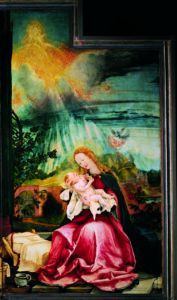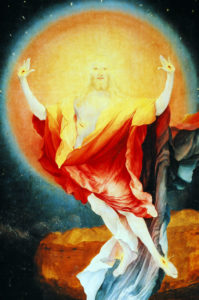24 May The Isenheim Altarpiece – Treasa O’Driscoll

I rejoice in the publication of an English translation of Michael Schubert’s magnificent book, The Isenheim Altarpiece, the original German edition of which was published in 2007 to wide acclaim. The three tiered, winged altarpiece was painted over 500 years ago by an artist of exceptional imagination and skill, Matthias Grunewald, about whom little is known. Commissioned by an Antonite abbott at the turn of the sixteenth century and mounted in the Isenheim monastery chapel, it became a source of hope and healing for hospice patients afflicted by St. Anthony’s Fire, a fatal disease caused by the consumption of contaminated rye. An icon of heavenly harmony and healing grace, the painting constitutes an antidote to the turbulent stream of our daily concerns in a time of unprecedented global unrest. The ever growing number of visitors to the museum in Colmar, France, where the polyptych is currently housed, attests to its enduring significance as a sublime and seminal artistic creation.
A true work of art is said to perform of its own accord the act of transforming the soul of the viewer. This purpose is implicit in the altarpiece. Like other great religious paintings of the Renaissance in which aesthetic and spiritual values are at one, its inherent marriage of beauty and truth is communicated through an inspired combination of colour and form. The beauty of these biblical images and the mysteries that attend them can leave us breathless in a part of the soul that has not been touched before, inducing a state of wonder, of peaceful calm and gratitude. This experience of beauty goes beyond words as does the recognition of its underlying truth, a word termed aletheia in the original Greek, which means unhiddeness,implying depths to be revealed beyond what meets the eye.
The reality of this response was borne out in the life of author, Michael Schubert. He was ‘shattered and overcome’,
moved to the core of his being when he stood before the Crucifixion panel of the altarpiece for the first time having discovered the Colmar Museum, located less than an hour’s drive from his home. He did not have a religious background or church affiliation but experienced a moment of epiphany, sensing that every gesture, every detail, every scroll is laden with meaning. Deep questions flooded into his mind, setting the course for the next forty years of his life when he would devote himself to piecing together the history and meaning of the altarpiece. Miraculously preserved despite all odds, it had been dismantled and moved between Germany and France over the centuries, escaping the hazards of war, eluding the covetous grasp of kings and collectors, always destined to advance the spiritual wellbeing of those drawn to study it.
Blind faith and a belief in miracles prevailed in Grunwald’s time but the painter appears to have been of a more evolved disposition and might have been a member of a secret society. The panels, apart from highlighting familiar biblical scenes, also give pictorial expression to unconventional religious viewpoints that are rooted in esoteric Christianity. The author of this book left no stone unturned in his efforts to decipher the countless details that are, he notes, like letters of a forgotten languageembedded in the panels.
Michael Schubert adopted a Goethean scientific approach in his research, keenly observing each detail while keeping an open mind until understanding dawned. His previous experience of Waldorf education had informed his appreciation of colour, which Goethe referred to as the deeds and sufferings of light. He recognized that every colour has a direct relationship with something spiritual and that it is in creating directly out of the play of light, darkness and colour that a true painting comes into being. Grunewalde had captured a shining, radiating, spiritual element in his approach to colours, most notably in the revealed glory of the Resurrection scene where the radiance has assumed a  condition like the lighting up of the sun.
condition like the lighting up of the sun.
The author has written this book in a spirit of gratitude, understanding and love, qualities that are evident in every aspect of his life and brought originally to bear in his work with behaviourally challenged children. I had the privilege of participating in three of the many interactive workshops he has conducted worldwide, with the help of his wife Inka, over the past ten years and have marvelled at his mastery in presenting the subtle themes embedded in the altarpiece and the broad scope of his wisdom and knowledge. This completely reworked and expanded English translation is remarkable in that the quality of the book’s production, the richness and clarity of its striking images and layout is commensurate with the sacred content it unfolds. It is a glowing example of what Rainer Maria Rilke had in mind when he declared: Our task is to show the Gods human things shining!
Treasa O’Driscoll